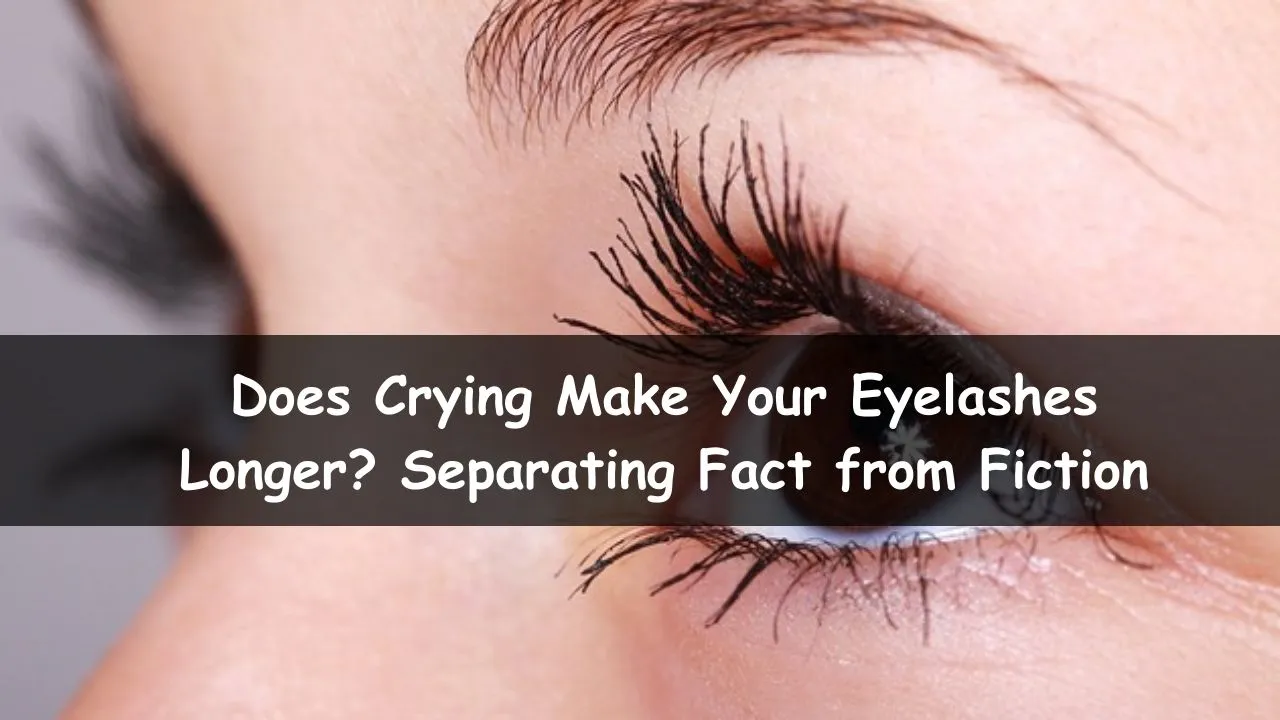Eyelashes have long been considered a symbol of beauty, and people are always searching for ways to make their lashes look longer and fuller. One of the more unusual suggestions that has been circulating in recent years is that crying can actually make your eyelashes longer. While this may seem like an unusual claim, there are some reasons why people believe this to be true. In this article, we will take a closer look at our main question “Does crying make your eyelashes longer?” and explore whether there is any scientific evidence to support it.
Benefits of crying?
One of the primary benefits of crying is that it can help to release pent-up emotions and reduce stress. When we cry, we release emotional tension and activate the parasympathetic nervous system, which can help calm us down and reduce feelings of anxiety or tension.
Crying can also be a way to express and process complex emotions, such as grief, sadness, or frustration. By allowing ourselves to cry and feel our emotions fully, we can better understand and work through these feelings, which can lead to greater emotional resilience and overall well-being.
Additionally, tears contain a number of substances that can help to lubricate and protect the eyes, including lysozyme, which has antibacterial properties, and lactoferrin, which can help to reduce inflammation.
Crying too Many side effects?
Before knowing about does crying make your eyelashes longer, we will check the side effects of excessive crying:
-
Eye irritation and redness
Eye irritation and redness refer to the inflammation and redness of the tissues around the eyes, which can be caused by various factors such as exposure to irritants, allergies, infections, or excessive crying. Symptoms of eye irritation and redness may include redness, swelling, itching, burning, and discomfort in and around the eyes.
-
Headaches and dehydration
Headaches and dehydration are two common side effects of excessive crying. Headaches may occur due to the release of stress hormones during crying, which can cause tension and pain in the head. Dehydration can occur because tears contain salt and other substances that can deplete the body of fluids. Symptoms of dehydration may include dizziness, fatigue, and dry mouth.
-
Emotional exhaustion and feelings of hopelessness
Emotional exhaustion and feelings of hopelessness are potential side effects of excessive crying, which can occur when we cry for extended periods of time. Emotional exhaustion can lead to feelings of fatigue, disconnection, and a lack of motivation. Feelings of hopelessness may arise due to the overwhelming and intense emotions experienced during crying. It is important to practice self-care and seek support from loved ones or mental health professionals if these side effects persist or worsen.
The Science of Eyelash Growth
Does crying make your eyelashes longer? Let’s know the science behind this. Eyelashes, like all hair, go through a natural growth cycle that is determined by genetics and other factors. The growth cycle consists of three phases: anagen, catagen, and telogen.
The anagen phase is the active growth phase, during which the hair follicle produces new hair cells. This phase lasts for about 30 to 45 days in eyelashes, and during this time, the hair grows longer and thicker. The length of the anagen phase determines the length of the hair, including eyelashes.
After the anagen phase, the hair enters the catagen phase, which is a transitional phase that lasts for about two to three weeks. During this time, the hair follicle shrinks and the hair stops growing.
How do Eyelashes grow?
Eyelashes grow in a similar way to other types of hair on the body. The growth process consists of three stages: anagen, catagen, and telogen.
During the anagen phase, which is also known as the growth phase, the hair follicle produces new hair cells that push the existing hair upward and out of the follicle. The length of the anagen phase determines the length of the hair, including eyelashes. The anagen phase for eyelashes lasts for about 30 to 45 days.
After the anagen phase, the hair enters the catagen phase, which is a transitional phase that lasts for about two to three weeks. During this time, the hair follicle shrinks, and the hair stops growing.
Finally, the hair enters the telogen phase, which is the resting phase. This phase lasts for about three to four months, during which time the hair follicle is inactive, and the hair remains in place. Eventually, the hair falls out, and the growth cycle starts over again.
Eyelashes have a shorter growth cycle than other types of hair on the body, which is why they do not grow as long. Additionally, the growth cycle can be influenced by factors such as age, genetics, hormones, and overall health.
Debunking the Myth
The belief that crying can make your eyelashes longer is a popular myth that has gained traction in recent years. While it is true that tears contain certain nutrients and proteins that are beneficial for the skin around the eyes, there is no evidence to suggest that these substances can actually promote eyelash growth.
In fact, excessive crying can actually be harmful to the skin and hair follicles around the eyes. The salt and other substances in tears can cause irritation and inflammation, which can damage the hair follicles and inhibit growth. Additionally, the act of crying itself can lead to rubbing and tugging on the delicate skin around the eyes, which can cause further damage.
While there are many products and treatments available that claim to enhance eyelash growth, the truth is that there is no proven way to speed up the growth cycle of eyelashes. The growth cycle is determined by genetics and other factors, and cannot be influenced by outside factors.
Instead of relying on unproven myths or gimmicks, the best way to promote healthy eyelash growth is to take good care of your lashes. This includes using gentle cleansing products, avoiding harsh makeup removers, and nourishing your lashes with natural oils and serums. By taking these steps, you can help to keep your lashes healthy and strong and enhance their natural beauty.
Why Crying Doesn’t Make Eyelashes Longer?
As we have learned about the answer of does crying make your eyelashes longer, now it’s time to learn about why crying does not make eyelashes longer. While it is a common belief that crying can make your eyelashes longer, there is no scientific evidence to support this claim. The idea that crying promotes eyelash growth likely comes from the fact that tears contain certain nutrients and proteins that are beneficial for the skin and hair around the eyes.
However, simply having these nutrients present in tears does not necessarily mean that they can penetrate the hair follicles and stimulate growth. In fact, excessive crying can actually be harmful to the skin and hair around the eyes.
The salt and other substances in tears can cause irritation and inflammation, which can damage the hair follicles and inhibit growth. Additionally, the act of crying itself can lead to rubbing and tugging on the delicate skin around the eyes, which can cause further damage.
Conclusion
The most asked question is, does crying make your eyelashes longer? Well, there is no scientific proof behind the growth of eyelashes and it is chiefly considered a myth. Yes, there are certain nutrients and proteins present in tears but they only help the skin around the eyes. So, it is safe to say that crying does not make your eyelashes longer but provides benefits to your skin. However, it depends on the person’s genetics and body.
Frequently Asked Questions
Q1: Does crying make your skin clear?
Ans: There is no scientific evidence to support the idea that crying can directly make your skin clear. However, crying can have some indirect benefits for your skin.
Q2: Can crying be bad for your health?
Ans: Excessive crying can cause eye irritation, dehydration, and emotional exhaustion.
Q3: Can crying help to relieve stress?
Ans: Yes, crying can help to release emotional tension and reduce stress.
Q4: Is it normal to cry often?
Ans: Crying frequency can vary from person to person and is considered normal as long as it does not interfere with daily life.
Q5: Can crying cause physical changes in the body?
Ans: Yes, crying can cause changes in hormone levels and reduce inflammation, which can have physical effects on the body.




[url=http://valtrexbt.online/]valtrex pills for sale[/url]
Great site, I just did my first order and they provided the 1,000 followers just like they said they would!
It works and it’s fast, I recommend
This is a great application, thanks to them my channel finally started to live, I recommend
A wonderful service which caters to the masses.
sekabet güncel
Dental cihazlar
They give good quality work and always willing to work with you.
Avcılar bölgesinde araçlarınızın, lastik tamiri, akü takviye ve yol yardıma ihtiyacınız varsa bizimle iletişime geçebilirsiniz.
Başakşehir bölgesinde araç arıza, lastik tamiri ve yol yardıma ihtiyacınız varsa bizimle iletişime geçebilirsiniz.
Awesome. Very clear. They are an awesome website. Will visit and use again!
This service was fantastic! Best purchase yet! I haven’t experienced any dropped followers at all, through the 2 months I’ve had them. Also, the followers are real people, they are not bots. Helped out a lot would definitely recommend for anyone share with your friends and family!!!
The service offered is very satisfactory and it is 100% good for everyone
Actually really nice, great group of individuals.
Thank you for the free sample! I appreciate it greatly, I hope you’re doing well!
Actually really nice, great group of individuals.
Wow, amazing blog structure! How long have you ever been running a blog for?
you make blogging glance easy. The whole look of your site is great,
let alone the content! You can see similar here ecommerce
Impressive craftsmanship, each item feels like a masterpiece.”
Indian Hindi Blue Film And Bf Sex Videos